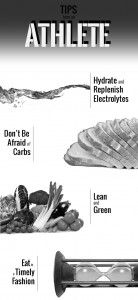Pepperdine competes in the most competitive NCAA division in the nation and against the top teams in many sports. The Waves have won 12 NCAA Division I championships, and continue to produce powerhouse athletes every year. Athletes such as MLB player Danny Worth and soccer stars Anisa Guajardo and Roxanne Barker prove that the Waves bring in and produce some of the great athletes in professional sports.
Hard work and excellent coaching are fundamental components to the path of success, but self-discipline is a skill that athletes hone to refine every aspect of their game. It is simple advice for anyone looking to tone up and gain a competitive edge in athletic performance, to eat more leafy greens and high protein meals. Here are four simple tips from an athlete that can take your performance to the next level:
No. 1 Hydrate and replenish electrolytes
In sunny Malibu, the Waves focus on taking in above-average amounts of sodium, electrolytes and water. The sunshine around these parts is a double-edged sword that causes great amounts of sweating and dehydrates the body faster than in cold temperatures. The old “eight glasses” rule no longer fits the bill. One old-school rule that hasn’t gone out of style is checking urine color to determine hydration level — the less yellow, the better.
Athletes who suffer from muscular cramps often increase water and sodium intake. Muscle control is dependent on a well-hydrated system.
No. 2 Don’t be afraid of carbs
When increasing physical activity, it is imperative to increase caloric intake. If the body is not fueled, it will burn muscle once glycogen stores are depleted. Muscle is a lot more difficult to gain back than it is to lose. One thing Pepperdine athletes don’t worry about is being judged when they go back for a second helping. But beware, one common athlete problem is eating enough while rolling on a Caf card budget.
Track captain Juliet Casillas said, “One of the struggles of being an athlete is always being out of Caf points, because I’m always eating.”
No. 3 Lean and green
Malibu Yo is a staple to any Pepperdine student’s diet, but sugars and fats are the main areas that should be curbed. Not to an extreme, since fats are necessary in a diet, but in the high-calorie, low-nutrition food world of today, awareness is key to maintaining good focus and enhancing performance.
Why does one crave these foods? Well, theories date this instinctual desire back to when humans had to earn every meal. High-calorie foods were necessary to stay healthy since food was less accessible. Now a trip to Ralphs or the Caf is all it takes to provide oneself with food. High-calorie foods are not as crucial to the human diet. Here’s a secret to keep in mind in a grocery store: All the essential food groups are usually covered on the outskirts of the store. The inside aisles tend toward processed and junk foods. One could obtain every food group just by shopping the walls of Ralphs or Trader Joe’s.
The salad bar might be the best vegetables Pepperdine has to offer, but keep in mind that the dark green and purple vegetables are packed with the most nutrients. As an athlete, I recommend kale, Brussels sprouts and beets as some of the top-notch vegetable options.
No. 4 Eat in a timely fashion
Athlete or not, breakfast plays a key role in waking up one’s metabolism and starting the day off on a high note. Breakfast should typically be the biggest meal of the day, as it provides the necassary fuel for the activities ahead.
In cross country and track, the difference between first and last place could depend entirely on the pre-race meal. Similarly, before working out, there are some general rules that will help prevent stomach problems and allow for optimal energy use. Typically, athletes should eat a meal two to three hours before competition. One hour before is the ideal time for fueling with a snack or PowerBar. Hydrating is a process that should occur constantly until 20 minutes before the big event.
Whether you classify yourself as a “grazer” or a “big-deal eater,” make sure not to skip meals. Not eating will cause the body to go into starvation mode and preserve fat and burn muscle instead. Athletes understand that it is crucial to keep the body properly fueled and healthy.
Key words in the athletic world are hydration, carbs and greens. These are important aspects of anyone’s nutrition since most individuals do not get the correct values of each their body’s needs.
From a young age, athletes have been taught what to eat and what to avoid, but mastering when to eat is a challenge of trial and error. Refueling the body is crucial to optimum performance and focus, whether for a track meet or a biology exam.
Have you ever wondered what an early-morning cyclist, a yoga enthusiast and a nationally ranked athlete need in order to perform and feel their best? The answer is two words: proper nutrition.
____________________________________________________________________________
Follow Stasia Demick on Twitter: @sdemick12

